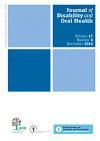Community Dental Health

- Cover Date:
- September 2012
- Print ISSN:
- 0265 539X
- Vol:
- 29
- Issue:
- 3
Caries in five different socio-economic clusters in Örebro county
Aim: This study assessed the prevalence of socio-demographic clusters in a Swedish county and the relationship of socio-demographic clusters and caries. Methods: All 2-19-year-olds (n=58,573) who attended a routine check-up in Örebro County in 2005-2007 were involved in this study. Initially, two-stage cluster analyses were used to identify outliers. Secondly, the Ward method which is a hierarchical clustering method was used to conduct the final analysis. Bivariate logistic regression was also used to study the relationship between cluster membership and caries. The smallest study unit used in the initial analysis for geographical area is known as key code area, which is a geographical entity defined by the municipalities themselves. Decayed surface (DS/ds) has been used as a measure of dental caries. Results: The county of Örebro clustered in five different socioeconomic clusters. Each cluster was defined by proportion of people over 75 years, native-born, single parents, and those with low incomes and low level of education. Odds ratio (OR) for having DS/ds>0 in the last dental check-up during 2005-2007 was 1.5 (cluster 1), 1.3 (cluster 2), 1.4 (cluster 3) and 3.8 (cluster 4) compared with the most socioeconomically favoured cluster (cluster 5). Conclusion: Cluster analysis of socioeconomic data is a useful tool to identify neighbourhoods with different socio-economic conditions.
Key words: socioeconomic factors, oral health, child, adolescent, dental caries, Sweden
- Article Price
- £15.00
- Institution Article Price
- £
- Page Start
- 229
- Page End
- 232
- Authors
- G.Ekbäck, C.Persson
Articles from this issue
- Title
- Pg. Start
- Pg. End
- Editorial - Population based health and care: what does the new dental professional need to know?
- 194
- 194
- Dental Public Health in Action - The use of dental therapists as examiners in dental epidemiological surveys
- 195
- 197
- A service evaluation of patient pathways and care experiences of dentally anxious adult patients
- 198
- 202
- Assessment and validation of the oral impact on daily performance (OIDP) instrument among adults in Karnataka, South India
- 203
- 208
- High levels of periodontal disease among the older adult population in San Juan, Puerto Rico
- 224
- 228
